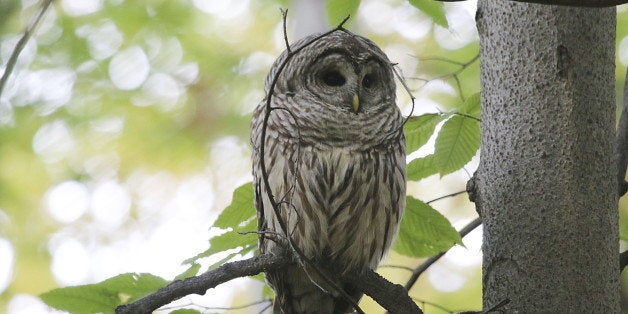
A recent essay in the magazine Conservation by science writer Warren Cornwall called "There Will Be Blood" is a must read for anyone interested in keeping up with current discussions and debates about the supposed need to kill animals of one species to save those of another species. The question at hand in this fine essay is, "Should barred owls be killed to save endangered spotted owls?" (See also "Birds and Us: Should Cormorants Be Killed to Save Salmon?"). Spotted owls are shy birds who favor ancient forests that are disappearing due to logging in the northwestern United States, and they are threatened by larger and more aggressive barred owls who have migrated west from their original homes on the east coast of the United States.
A conservation problem from hell
At the beginning of his piece Mr. Cornwall writes, "The pressure to reach for a gun to help save one animal from another is stronger than ever. And it has triggered a conservation problem from hell." He's right. Mr. Cornwall also notes that the history of conservation is "tinged with blood." For example, noted conservationists John Audubon and Aldo Leopold were quite comfortable killing members of one species to save members of another species, and so too are many conservationists nowadays. Mr. Cornwall provides some summary statistics for animals who were killed for conservation. These include 1.1 million lake trout and 60 California sea lions. There also are plans in the works to kill 16,000 double-crested cormorants to protect salmon and to poison 4000 ravens to help the greater sage grouse.
The United States government also sanctions mass and wanton killing. Mr. Cornwall's summaries of body counts of animals killed by Wildlife Services, aka Murder Inc., is truly sickening. Individuals working for Wildlife Services kill millions of animals every year, including two million European starlings and more than one million brown-headed cowbirds. It's really heartening that their murderous ways are under investigation by members of Congress and various organizations including Project Coyote and Predator Defense
Unacceptable alternatives and a planned killing experiment: Is there a suitable exit strategy?
Concerning the owls, there are varied opinions. Bob Sallinger, conservation director of the Audubon Society of Portland, Oregon, notes, "On the one hand, killing thousands of owls is completely unacceptable. On the other hand, the extinction of the spotted owl is completely unacceptable."
So, what should be done? While some favor killing barred owls, others say let nature take its course. Some say it will work and some say it won't. Mr. Cornwall asks a most important practical question: "What's the exit strategy? Can we kill 10,000 barred animals every year forever?" That's the magic number some experts talk about in discussions about what it will take to help spotted owls. Killing experiments by the United States Fish and Wildlife Service are in the planning stages in only two percent of spotted owl habitat in Washington, Oregon, and northern California, at a cost of about $4 million and thousands of dead barred owls (approximately $1000 per dead bird). And, there will be collateral damage.
Compassionate conservation: Every individual counts
My take, following the basic tenet of compassionate conservation (see also) that every individual animal matters, is that the barred owls shouldn't be killed. Not only is it entirely unpredictable that killing the barred owls will work to save spotted owls because the project is daunting and will have to go on forever, it also is wrong to kill members of one species for the benefit of another species. We need to start somewhere, and the guiding principle of compassionate conservation, "First do no harm," is a good place to begin. (I can send a copy of this essay to those who email me.) I would vote "No" on this option if a vote were taken. I surely would not support experimentally killing birds to see if it would work.
Experimentally killing barred owls is a "sad good"
Some do not agree with my position. Ethicists, Bill Lynn, who was hired by the Fish and Wildlife Service and who was initially skeptical about the above killing experiments, changed his mind. He concluded that it was all right to kill the barred owls as an experiment if it was done as humanely as possible, and called it a "sad good." For me, a "sad good" is a very slippery slope that sets a lamentable precedent for opening the door for the more widespread "experimental killing" of barred owls and other species. Dr. Lynn balked on supporting a region-wide war on barred owls.
Let nature take its course: This is a fight that can't be won
Clearly, this is very difficult terrain to negotiate. Kent Livezey, a retired Fish and Wildlife Biologist, doubts that there will be public support for "open-ended mass owl killing with no clear exit strategy." Although Mr. Livezey worked for years to save spotted owls he concludes, "Personally, I would just let nature takes its course." This is a fight that can't be won.
My simple suggestion is to read Mr. Cornwall's excellent essay and share it widely. It is that good, and it is short, readable by a wide audience including non-biologists, balanced, and right to the point. The question at hand -- should we kill in the name of conservation -- isn't going to disappear anytime soon, if at all. Good people who care about other animals, with admirable goals, disagree on the need to kill for conservation. Some say that using the most humane killing methods available is the best and most compassionate way to act. Others see little compassion in that claim because there always will be pain and suffering and individuals are being killed even if they're healthy and thriving.
What should the future of conservation look like? When will the killing stop?
Open discussion and debate about the vexing and daunting question that centers on asking if we should kill for conservation is much-needed as we head into a future where more and more species will become imperiled and endangered because of what we are doing to them and to their dwindling habitats. We choose to destroy their homes and then we choose to destroy them. There is something very wrong, disheartening, and disingenuous about this course of action.
We're going to have to make hard choices in the future, and choosing not to kill in the name of conservation is a viable one that is now on the table. Do we really want to continue the bloody history of conservation strategies? Time will tell, but times are changing. As we rewild our hearts the killing should surely stop.
Friends of Animals has filed a suit to stop the killing of the barred owls because it violates the Migratory Bird Treaty Act and the National Environmental Policy Act..
